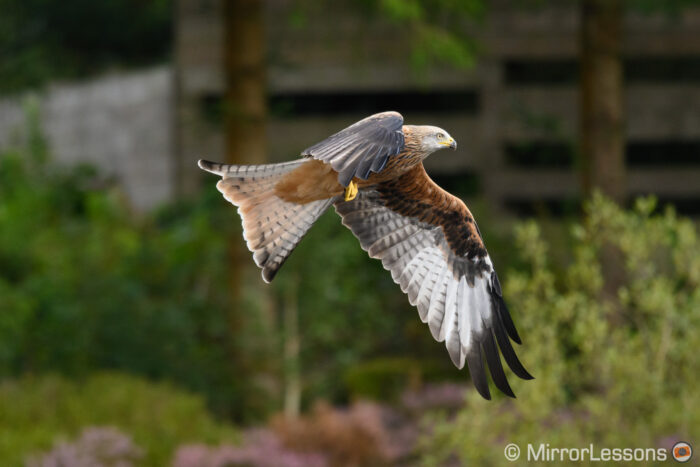The Canon R10 and the Nikon Z50 are the most affordable cameras you can find for the RF-mount and Z-mount mirrorless system respectively.
They share a few similarities, but there are also a lot of differences that may tempt you to choose one over the other.
Let’s see how they compare.
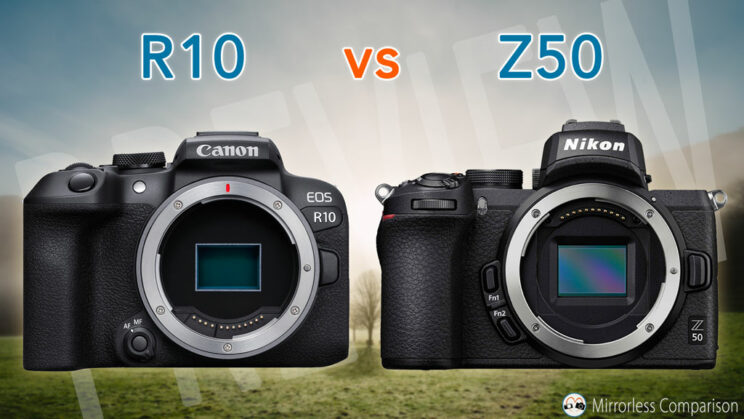
You might also be interested in:
Ethics statement: the following is based on official specs for the R10 and our personal experience with the Z50. We were not asked to write anything about these products, nor were we provided any compensation of any kind. Within the article, there are affiliate links. If you buy something after clicking one of these links, we will receive a small commission. To know more about our ethics, you can visit our full disclosure page. Thank you!
1. Sensor
Both cameras feature an APS-C sensor (Nikon calls this format DX). The R10 has 24.2MP whereas the Z50 has slightly less resolution with 20.9MP.

Note that the dimensions between Nikon and Canon’s APS-C format are slightly different, with the R10 sensor being a bit smaller (the crop factor on the Canon is 1.6x as opposed to 1.5x for the Z50).
- Nikon’s DX: 23.5 mm x 15.7 mm
- Canon’s APS-C: 22.3 × 14.9 mm
This hardly matters when it comes to real world results, but the more technical among you might like this extra piece of information.
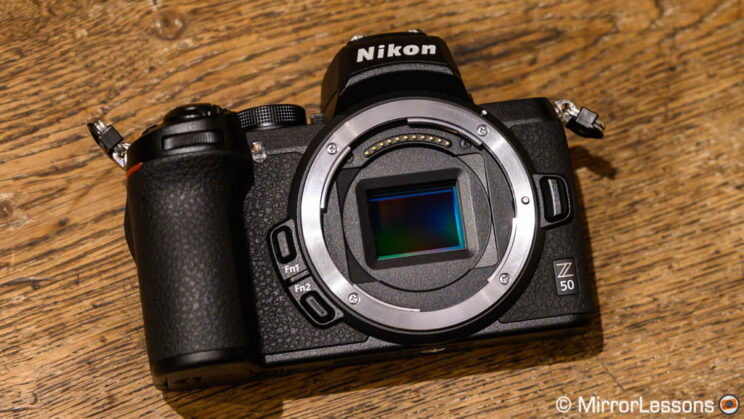
The Z50 has a small advantage in terms of ISO performance, both regarding the normal and extended range.
Camera
Normal range
Extended range
R10
100 – 32,000
100 – 51,200
Z50
100 – 51,200
100 – 204,800
The Canon can record 10-bit HDR files (Heif, with the HDR PQ gamma) in addition to RAW and JPG.
2. Autofocus
The R10 features Canon’s Dual Pixel CMOS AF II system, and the software comes from the flagship R3 model, especially regarding the deep learning algorithm. The camera can detect the head, eyes or body of humans and animals (including birds). It can also recognise cars and motorcycles, and prioritise the helmet of the driver.
The Z50 autofocus is less advanced. There is face and eye detection for people, as well as Eye AF for cats and dogs, but it can’t recognise the body of its subject, nor does it have advanced modes for motorsports or other such things. That said, the camera did better than expected in my birds in flight test.
Concerning the AF points, the R10 works across the entire sensor surface, with a maximum of 4,503 points (single area mode) or 651 points (when Tracking is enabled).
The Z50 has 273 points that cover approximately 90% of the sensor.
The R10 has a minimum sensitivity in low light of -4EV, measured with an F1.2 lens, which corresponds to -2.5EV with an F2 lens.
The Z50 has a rating of -2EV, or -4EV if you activate the Low Light AF mode (which is slower but can help in very dim light conditions). This data is measured with an F2 lens.
The R10 has a few extra features concerning autofocus, like focus bracketing and focus stacking which will interest macro photograhers.
3. Continuous Shooting Speed
Here the R10 has a clear advantage. It can shoot up to 15fps if you use the mechanical shutter. Activate the electronic shutter, and it goes even faster at 23fps.

The Z50 goes up to 11fps with the mechanical shutter. The electronic mode doesn’t bring any benefits in this case.
Note that on the Canon, the e-shutter also extends the shutter speed to 1/16,000s, beyond the 1/4000s maximum speed available with the mechanical shutter on both cameras.
4. Design
The Nikon is a bit larger and slightly heavier than the Canon. Additionally, Nikon claims a certain degree of weather sealing, though don’t expect the same level as that found on higher-end cameras.
- R10: 122.5 x 87.8 x 83.4mm, 429g
- Z50: 126.5 x 93.5 x 60mm, 450g
Despite the compact size, both cameras have a large front grip on the front.
The R10 has a few extra controls you will appreciate such as the AF joystick on the rear, and the AF/MF switch at the front.
A built-in flash is also available on both cameras. That of the Nikon is slightly more powerful (GN7 vs GN6 on the Canon).
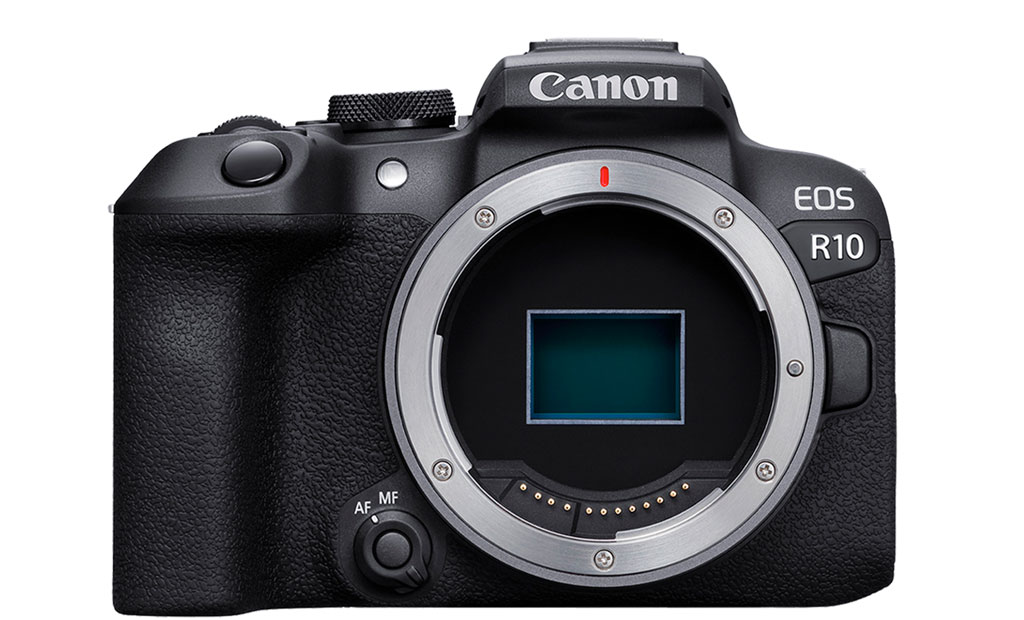
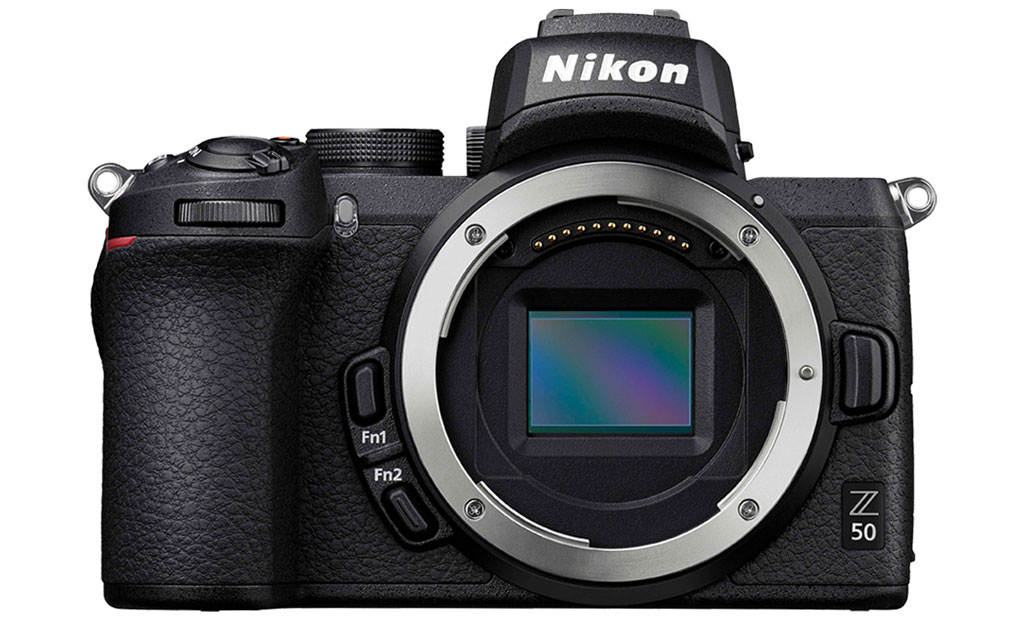
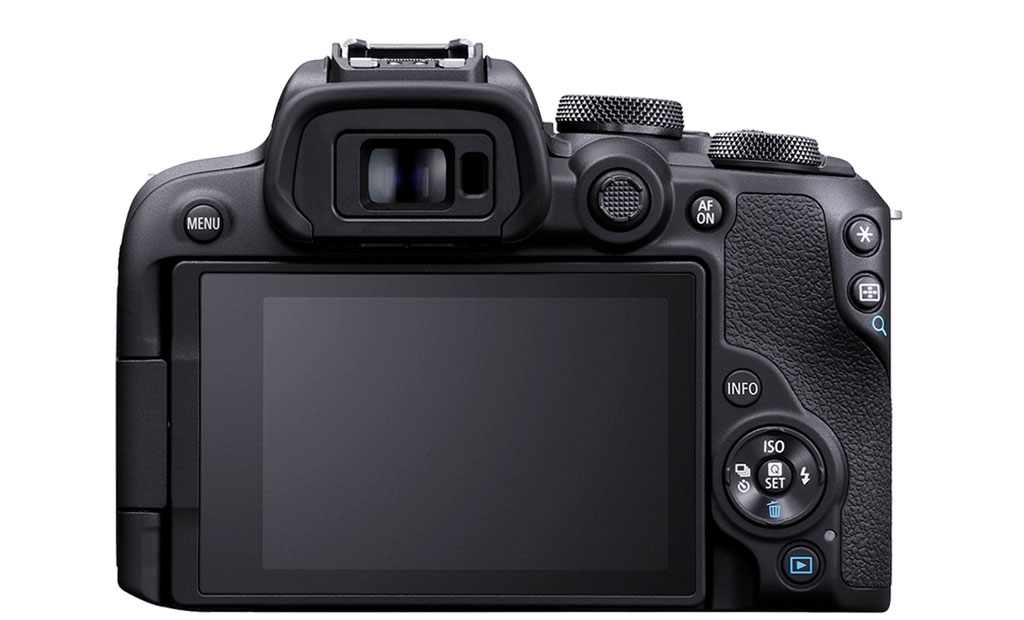
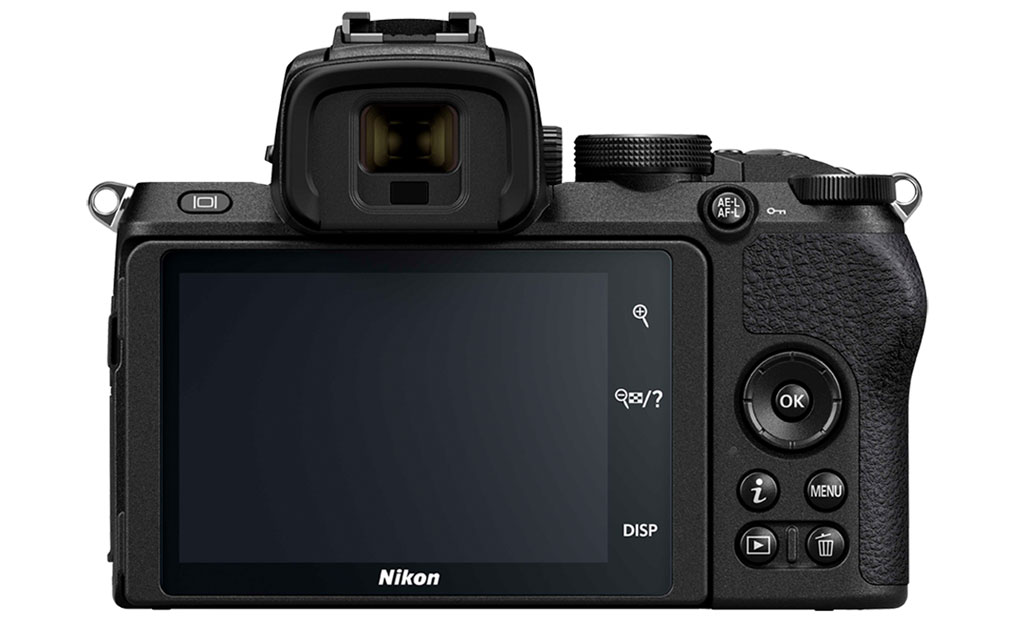
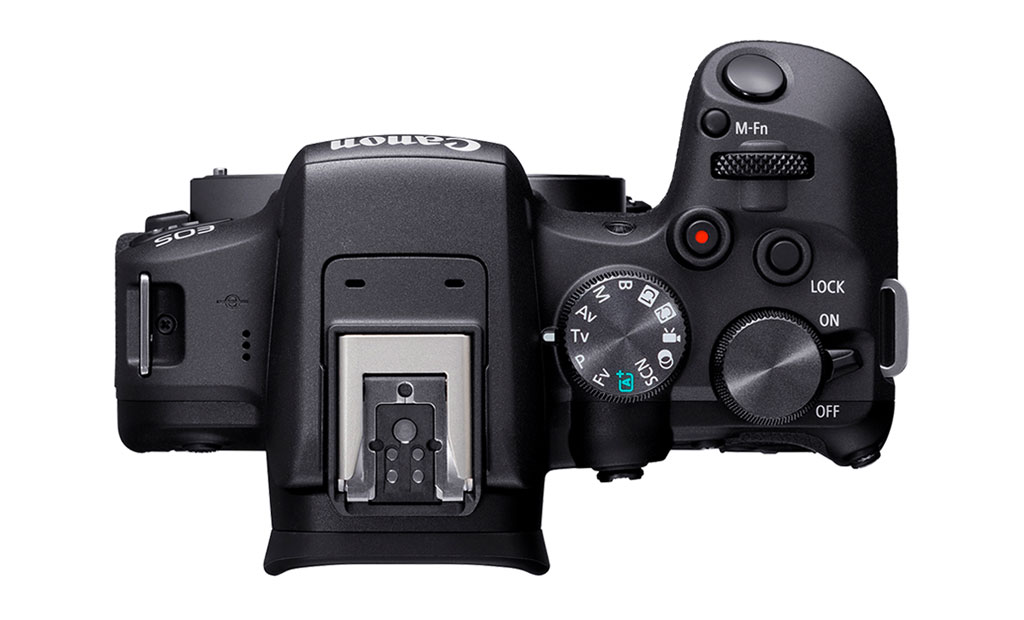
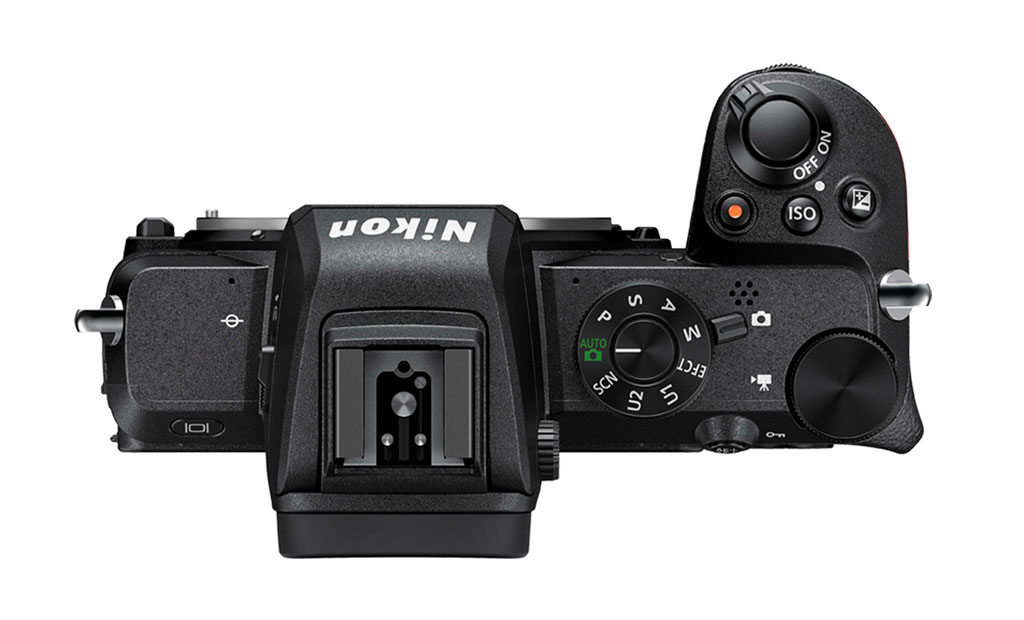
5. Viewfinder
Neither camera sports a particularly big viewfinder or impressive specs. The Z50 gives you more magnification but has a shorter eye point and a slower refresh rate. Here is how they compare.
EVF
R10
Z50
Panel
0.39-in OLED
0.39-in OLED
Resolution
2.36M
2.36M
Refresh rate
120Hz
60Hz
Magnification
0.59x
0.68x
Eyepoint
22mm
19.5mm
On the R10, Canon has added an option called OVF Assist, which simulates an optical viewfinder by disabling the exposure preview and increasing the brightness and tonal range.
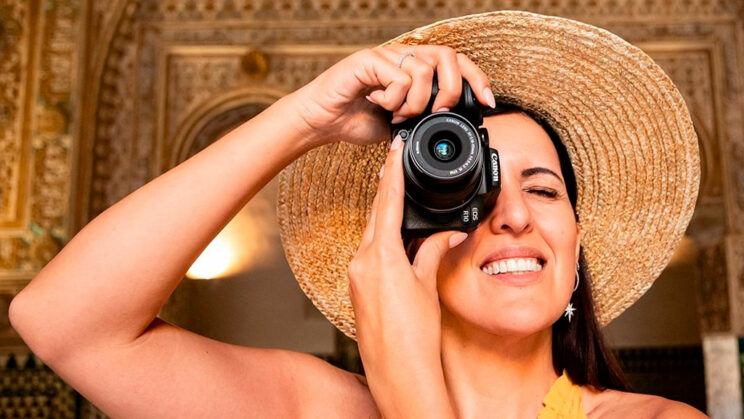
6. LCD monitor
Canon has opted for the multi-angle solution on the R10, where the LCD can be opened to the side and rotated 180˚ when needed.
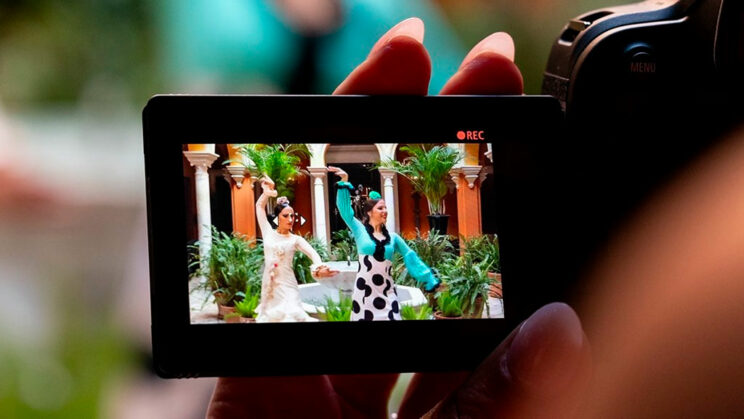
The monitor on the Nikon can be titled down to 180˚, and when you do so, the camera goes automatically into selfie mode, locking most buttons so that you won’t press them accidentally while holding the camera. While this solution is fine for casual photos or short V-logs, it also means you can’t use the screen when recording yourself with the camera on a tripod for example. The R10 solution feels more apt for a variety of situations.
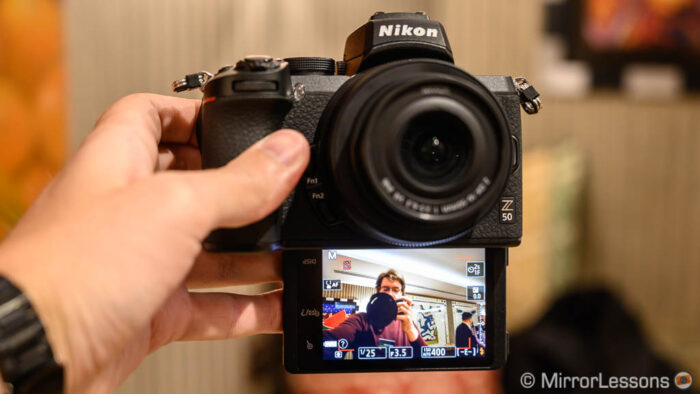
One nice aspect of the Z50 is that the monitor is larger (3.2-in vs 3.0-in). The resolution is the same however: 1.04M dots.
Finally, both monitors are touch sensitive and there are various things you can do with it, including navigating the menu.
7. Video recording
The R10 can record 4K video up to 30p or 60p. With the latter, there is a severe 1.6x crop on the sensor, whereas 4K/30p works with the full width of the sensor.
The Z50 also records 4K up to 30p without a sensor crop, but there is no 60p option.
In Full HD, they can work up to 120p and deliver slow motion results in camera.
The Canon can record in 10-bit 4:2:2 internally but only when selecting the HDR PQ setting. The Z50 doesn’t have any 10-bit option, nor does it have Log or HLG curves.
Finally, both cameras have a mic input but no headphone output. The R10 can also record digital audio via the multi-function shoe and a compatible microphone.
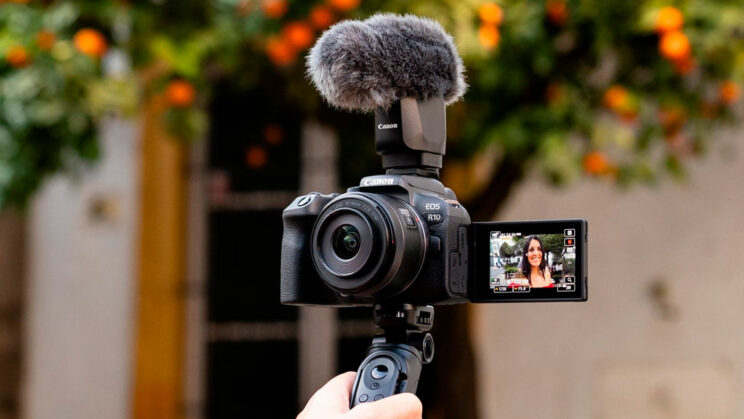
8. Battery life
The R10 has a rating of 430 frames when using the LCD, or 260 frames when working with the viewfinder.
The Z50 has a rating of 320 shots, although they don’t specify if it is measured with the LCD or EVF.
Both batteries can be charged in-camera via the USB port.
9. Lens system
At the time of publishing this article, there are only two lenses designed for Canon’s APS-C cameras: the RF-S 18-45mm kit lens and the RF-S 18-150mm.
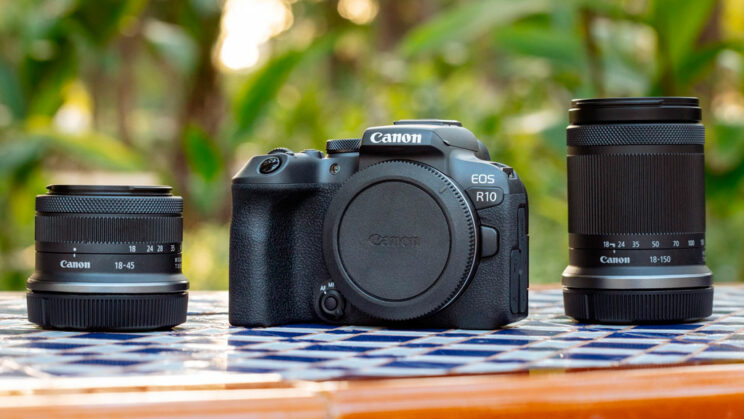
If you want more than that, like a fast prime lens for portraits for example, you’ll have to either look at the full frame RF lenses, or get the camera with the adapter and use Canon’s DSLR lenses.
The Z50 doesn’t offer a lot more to be honest: only three lenses are designed for the DX format, including a longer telephoto (50-250mm). Otherwise, here as well you need to look at the full frame Z lenses, or use Nikkor F lenses with an adapter.
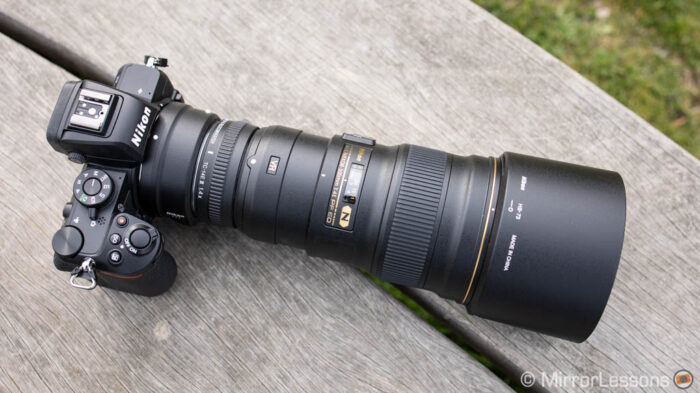
That said, there seems to be a bit more for Nikon from third party lenses. Viltrox, in particular, has produced a few interesting primes with autofocus and an affordable price.
Needless to say, both systems need to up their game if they want to take the APS-C segment more seriously. I can see Canon developing more lenses in the near future (some are already rumoured) because it has a camera with higher specs (the R7), whereas it is unclear how much Nikon wants to expand its DX mirrorless system. For now, only the Z50 and its retro-vintage version Z fc have been released.
10. Price
The Canon R10 can be found for $980 / £900 / €1030, for the body only.
If you want to buy it with the 18-45mm kit lens, the prices are: $1100, £1000 or €1000.
The Z50 is a bit cheaper with prices around $850, £900 for the body only. With the 16-50mm kit lens, it will cost you $1000, £1040 or €1050.
Prices as of early June 2022.
You might also be interested in:
Conclusion
Unless if you have specific needs, I can’t see you going wrong with either of these cameras, especially if you’re looking at your first.
The R10 is a bit more interesting specs-wise, offering a more advanced autofocus, faster continuous shooting and more options for video. It also has more physical controls and I prefer its LCD mechanism.
The Z50 is a bit less expensive, and you can also find a few more affordable and fast prime lenses, as soon as you get bored of the kit lens. That said, if Canon works quickly, it might have more to offer lens-wise by next year.
Reminder: the links below are affiliate links. If you decided to buy something after clicking the link, we will receive a small commission.
Check price of the Canon R10 on
B&H Photo
Check price of the Nikon Z50 on
Amazon | Amazon UK | B&H Photo | eBay

